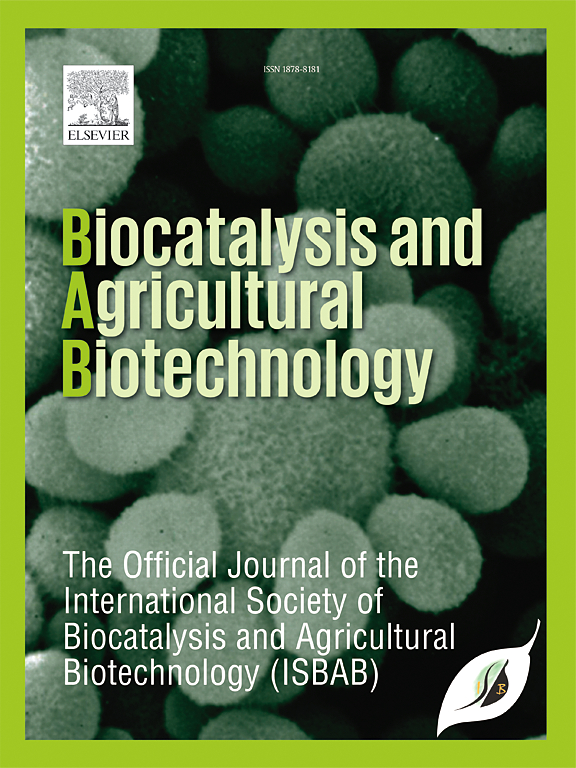Valorisation of biowaste for the production of high-quality irrigation water: A sustainable approach in hydroponic wheat cultivation
IF 3.4
Q2 BIOTECHNOLOGY & APPLIED MICROBIOLOGY
引用次数: 0
Abstract
Faced with the increasing scarcity of water and the challenges of organic waste management, this study proposes an innovative method for valorizing biowaste to produce high-quality irrigation water by combining thermal drying and biofiltration. Three types of biowaste, including potato peels, orange peels, and coffee grounds, were treated using devices with or without biofilters, incorporating ashes derived from Hermetia illucens L. or Cupressus atlantica G. Each thermal cycle operated at 55 °C for 24 h and treated 100 g of fresh biowaste, yielding on average 60 ml of condensed water per cycle. Physicochemical, microbiological, and agronomic analyses revealed that the device without a biofilter produced water rich in biodegradable nutrients (BOD5: 1103 mg/l), promoting an average germination rate of 93.22 % and optimal vegetative growth of wheat in hydroponic systems. In contrast, devices equipped with biofilters effectively reduced organic load (COD: 461.66 mg/l for Cupressus atlantica and 70.44 mg/l for Hermetia illucens L.) while eliminating microbial contaminants, with no detectable traces of heavy metals. The Cupressus atlantica G..-based biofilter achieved a high germination rate (94.55 %) due to the controlled release of mineral salts, whereas the Hermetia illucens L.-based biofilter resulted in a germination rate of 85.10 %, highlighting the critical balance between nutrient availability and contaminant reduction. These findings demonstrate the potential of this technology to produce environmentally friendly water suitable for sustainable irrigation and circular resource management. This approach offers a promising solution to address the dual challenges of water scarcity and biowaste valorization.

生物废弃物的增值生产高质量灌溉用水:水培小麦种植的可持续途径
面对水资源日益短缺和有机废物管理面临的挑战,本研究提出了一种结合热干燥和生物过滤的生物废物增值生产高质量灌溉用水的创新方法。三种类型的生物废物,包括土豆皮、橘子皮和咖啡渣,使用有或没有生物过滤器的设备进行处理,其中包括来自Hermetia illucens L.或柏树atlantica g .的灰烬。每个热循环在55°C下运行24小时,处理100克新鲜生物废物,每个循环平均产生60毫升冷凝水。理化、微生物学和农艺分析表明,不加生物过滤器的装置产生的水富含可生物降解营养素(BOD5: 1103 mg/l),促进水培系统中小麦的平均发芽率为93.22%,营养生长最佳。相比之下,配备生物过滤器的装置有效地降低了有机负荷(大西洋柏树的COD为461.66 mg/l,黑耳草的COD为70.44 mg/l),同时消除了微生物污染物,没有检测到重金属的痕迹。大西洋柏树由于无机盐的可控释放,基于生物滤池的发芽率高达94.55%,而基于Hermetia illucens l .的生物滤池的发芽率为85.10%,突出了养分有效性和污染物减少之间的关键平衡。这些发现证明了这种技术在生产适合可持续灌溉和循环资源管理的环境友好型水方面的潜力。这种方法为解决水资源短缺和生物废物增值的双重挑战提供了一个有希望的解决方案。
本文章由计算机程序翻译,如有差异,请以英文原文为准。
求助全文
约1分钟内获得全文
求助全文
来源期刊

Biocatalysis and agricultural biotechnology
Agricultural and Biological Sciences-Agronomy and Crop Science
CiteScore
7.70
自引率
2.50%
发文量
308
审稿时长
48 days
期刊介绍:
Biocatalysis and Agricultural Biotechnology is the official journal of the International Society of Biocatalysis and Agricultural Biotechnology (ISBAB). The journal publishes high quality articles especially in the science and technology of biocatalysis, bioprocesses, agricultural biotechnology, biomedical biotechnology, and, if appropriate, from other related areas of biotechnology. The journal will publish peer-reviewed basic and applied research papers, authoritative reviews, and feature articles. The scope of the journal encompasses the research, industrial, and commercial aspects of biotechnology, including the areas of: biocatalysis; bioprocesses; food and agriculture; genetic engineering; molecular biology; healthcare and pharmaceuticals; biofuels; genomics; nanotechnology; environment and biodiversity; and bioremediation.
 求助内容:
求助内容: 应助结果提醒方式:
应助结果提醒方式:


